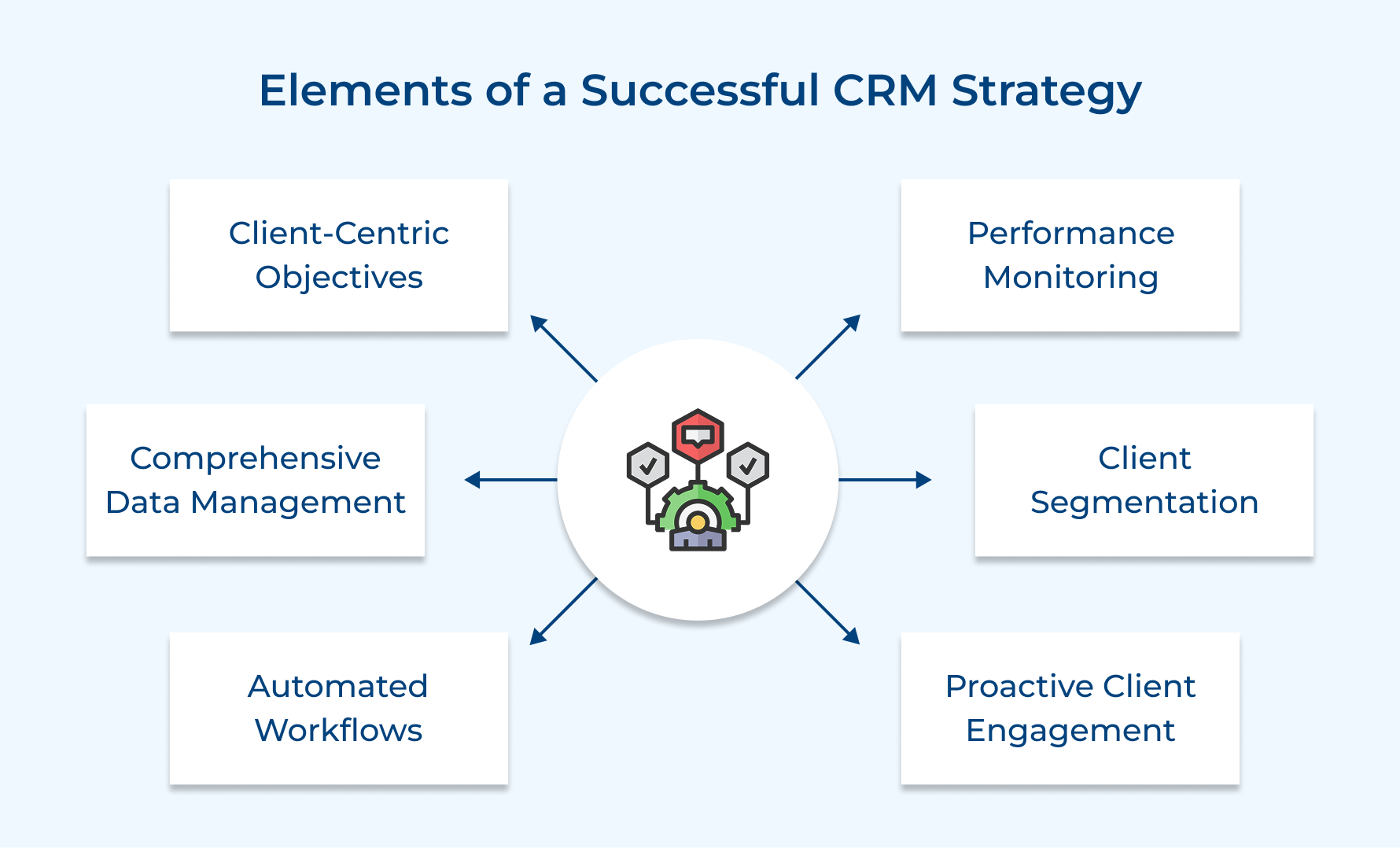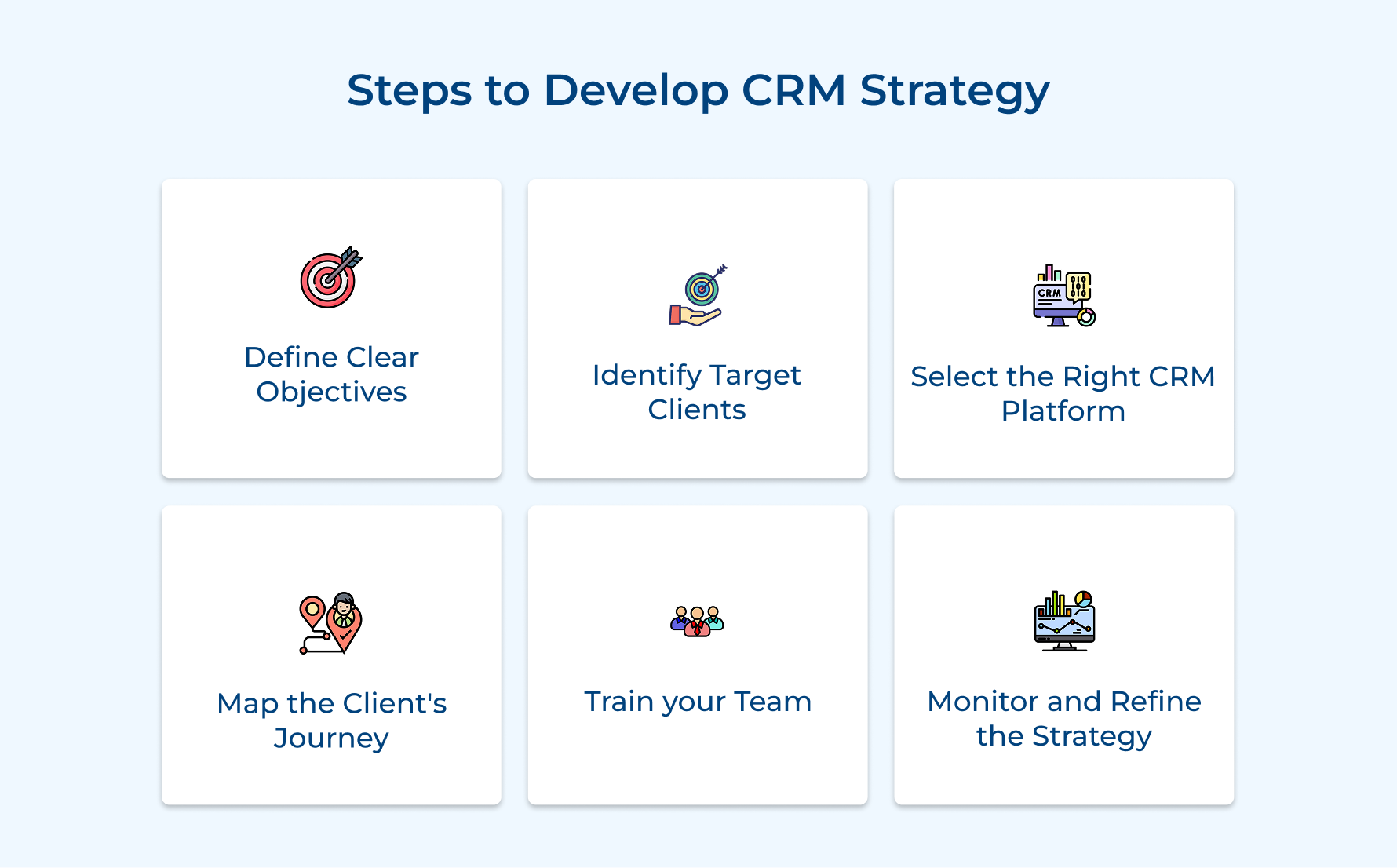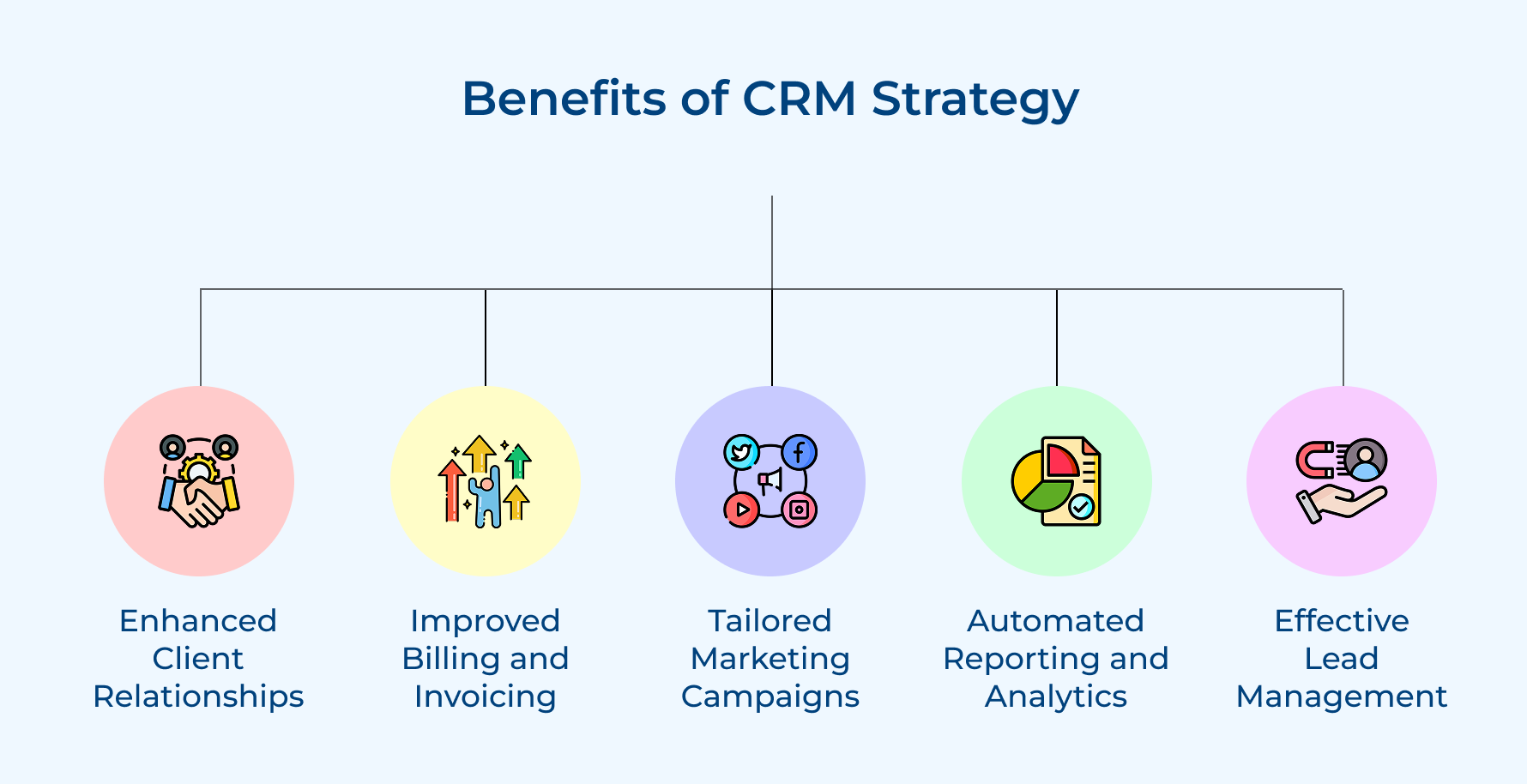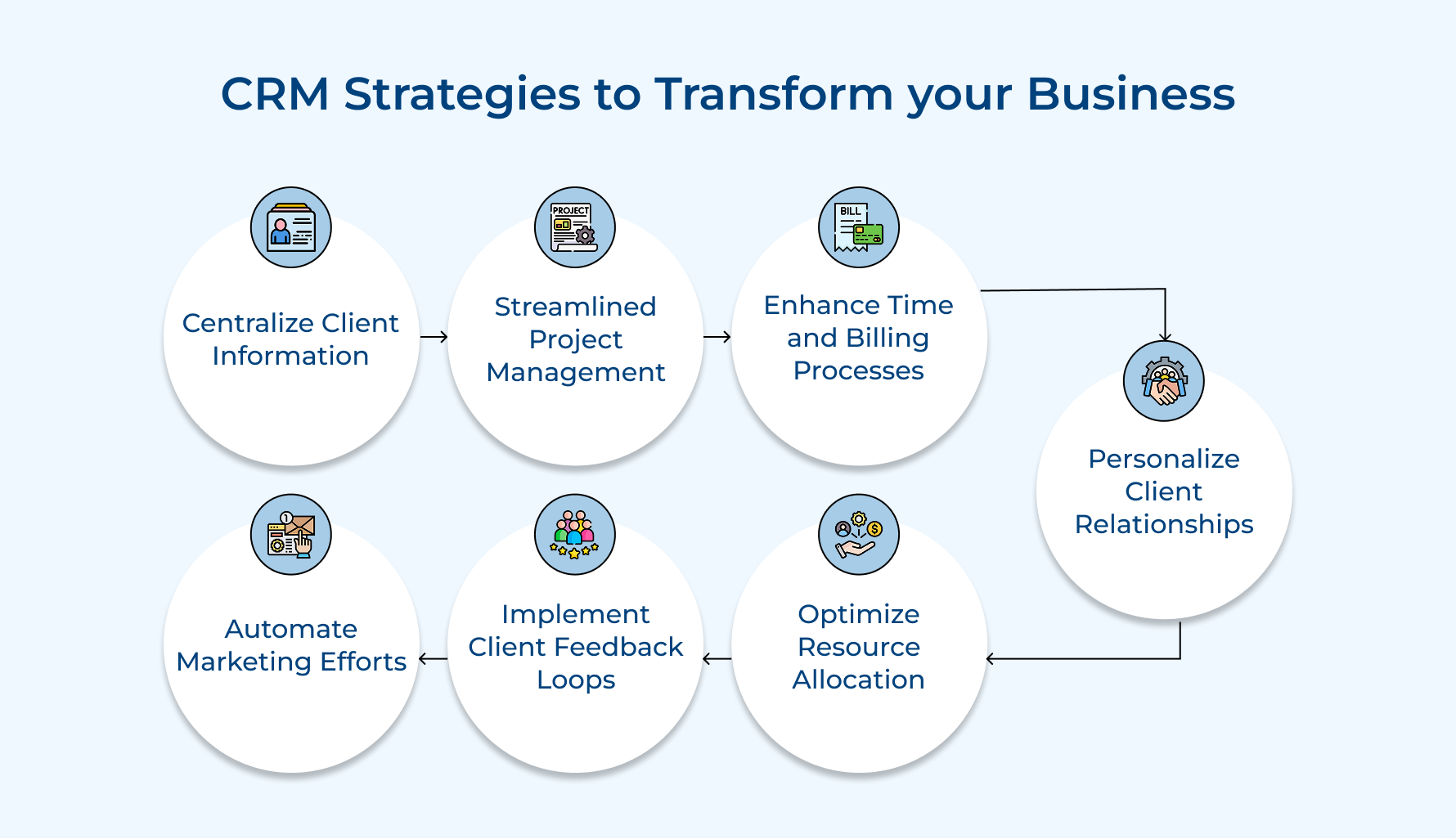6 Effective Steps to Develop a Robust CRM Strategy

Key Highlights
The increasing complexity of client needs and the demand for personalized service have left many firms struggling to keep up, risking client attrition as well as missed opportunities.
A robust Customer Relationship Management (CRM) strategy offers a powerful solution to these pressing issues. Every dollar spent on CRM gives an ROI of over $8!
Let us explore how a well-crafted CRM strategy can transform your professional services firm or agency. We’ll delve into the key components of an effective CRM approach and discuss common implementation challenges. Let’s also look into its actionable insights to help you harness the full potential of CRM in your organization.
What is a CRM Strategy?
A Customer Relationship Management (CRM) strategy is a comprehensive plan that organizations develop to optimize their interactions with current and potential customers. It encompasses the processes as well as technologies to acquire, retain, and enhance customer relationships throughout the lifecycle.
A robust CRM strategy enables companies to gain deeper insights into customer journeys, behavior, and preferences, allowing for more targeted marketing efforts along with improved customer service. A well-defined CRM strategy is crucial as it aligns the organization’s efforts toward encouraging deeper customer connections and driving sales growth.
Key objectives:
- Enhancing customer relationships: Building strong, lasting connections to boost customer retention as well as loyalty.
- Improving data management: Streamlining data collection and analysis to gain actionable insights for better decision-making.
- Increasing sales efficiency: Automating and optimizing processes for sales teams to maximize productivity as well as close rates.
Key Elements of a Successful CRM Strategy
A successful CRM strategy involves several key aspects like studying buyer, personas, offering personalized experience, etc. Here’s the list to build strong relationships.
1. Client-centric Objectives
Define clear, measurable goals that prioritize customer satisfaction and long-term relationship building. Focus on objectives that enhance client experience, increase retention, and drive referrals. Align these goals with your firm’s overall business strategy to ensure cohesive client-centric growth.
2. Comprehensive Data Management
Implement a robust system for collecting, organizing, and analyzing client data across all touchpoints. Ensure data accuracy and accessibility to provide a 360-degree view of each client relationship. The comprehensive approach enables informed decision-making and personalized service delivery.
3. Automated Workflows
Streamline repetitive tasks and processes through automation to improve efficiency as well as consistency. Implement automated workflows for lead nurturing, project management, and client communication. It frees up valuable time for high-value activities and ensures timely follow-ups as well as deliverables.
4. Performance Monitoring
Establish key performance indicators (KPIs) that reflect client satisfaction, project success, and business growth. Regularly track and analyze these metrics to identify areas for improvement as well as inform strategic decisions. Use data-driven insights to continuously refine your CRM strategy and service delivery.
5. Client Segmentation
Develop a systematic approach to categorizing clients based on industry, size, service needs, and potential value. Use this segmentation to tailor your services, marketing efforts, engagement strategies, etc. The targeted approach ensures efficient resource allocation and more effective client management.
6. Proactive Client Engagement
Implement strategies for ongoing, meaningful client interactions beyond project-specific communications. Utilize CRM data to anticipate client needs, share relevant insights, and provide value-added services. The proactive approach strengthens relationships and positions your firm as a trusted advisor.
How to Develop CRM Strategy: 6 Steps
Creating an effective CRM strategy involves a structured approach. Here are the six essential steps to guide your development process.
1. Define Clear Objectives
Clear objectives provide direction and purpose for your CRM strategy. They ensure that all efforts are aligned with the firm’s overall goals and help measure success. Without clear objectives, your CRM implementation may lack focus as well as fail to deliver tangible results.
Use objectives to guide CRM platform selection, customize features, and set key performance indicators (KPIs). They help prioritize CRM initiatives, allocate resources effectively, and create benchmarks for evaluating the strategy’s success over time.
Best practices:
- Align CRM objectives with your firm’s overall business strategy and long-term vision.
- Use SMART criteria (Specific, Measurable, Achievable, Relevant, Time-bound) when setting CRM objectives.
2. Identify Target Clients
Identifying target clients helps focus your CRM efforts on the most valuable and promising segments. Resource allocation becomes more efficient and enables the creation of tailored strategies for different client types.
Use target client profiles to customize CRM workflows, develop targeted campaigns with marketing teams, and develop specialized service offerings. The information can also guide business development efforts as well as help prioritize client acquisition and retention strategies.
Pro tips:
- Develop detailed client personas that include industry, size, pain points, and decision-making processes.
- Regularly upgrade target client profiles based on market trends and firm performance data.
3. Select the Right CRM Platform
The right CRM platform serves as the technological backbone of your strategy. It should align with your firm’s specific needs, integrate with existing systems, and provide the necessary features to support your objectives.
Use the CRM platform to centralize client data, automate processes, track interactions, and generate insights. It can facilitate collaboration among team members, streamline project management, and provide a 360-degree view of client relationships.
Best practices:
- Involve key stakeholders from different departments in the selection process to ensure the platform meets diverse needs.
- Prioritize platforms that offer customization options and scalability to accommodate future growth.
4. Map the Client’s Journey
Mapping the client journey provides a comprehensive view of all touchpoints and interactions throughout the client lifecycle. It helps identify opportunities for improvement, ensures consistency in service delivery, and enhances the overall client experience.
Use the client journey map to design CRM workflows, set up automated touchpoints, and identify critical moments for personal intervention. It can guide the creation of targeted content and help anticipate client needs at different stages of engagement.
Tips to consider:
- Include both internal and client-facing touchpoints in your journey map to get a complete picture.
- Regularly gather client feedback to refine and improve the mapped journey.
5. Train Your Team
Proper training helps your team to effectively utilize the CRM system and adhere to new processes. It promotes adoption, reduces resistance to change, and maximizes the return on your CRM investment.
Use training to familiarize staff with CRM features, establish best practices for data entry and management, as well as demonstrate how the CRM supports their daily tasks. Ongoing training can also introduce advanced features and reinforce the importance of CRM in client relationships.
Pro tips:
- Develop role-specific training programs focusing on how the CRM benefits each team member’s responsibilities.
- Implement a continuous learning approach with regular refresher courses and updates on new features.
6. Monitor and Refine the Strategy
Continuous monitoring and refinement ensure that your CRM strategy remains effective as well as aligned with changing business needs. It identifies areas for improvement and helps adapt to evolving client expectations along with market conditions.
Use monitoring to track KPIs, gather user feedback, and identify bottlenecks or underutilized features. Regular refinement can involve adjusting workflows, updating automation rules, or implementing new integrations to enhance CRM functionality.
Best practices:
- Establish a regular review cycle (e.g., quarterly) to assess CRM performance against set objectives.
- Create a feedback loop that includes input from both CRM users and clients to drive continuous improvement.
Key Benefits of CRM Strategy
Implementing a robust CRM strategy provides significant advantages. Here are the key benefits that can enhance your organization’s performance.
1. Enhanced Client Relationships
A CRM strategy enables firms to maintain detailed client histories, preferences, and interactions. The comprehensive view allows professionals to provide personalized service, anticipate client needs, and encourage stronger relationships. Centralizing client information facilitates effective team collaboration, ensuring consistent and high-quality service across all touchpoints.
2. Improved Billing and Invoicing
CRM systems streamline billing processes through accurate tracking of billable hours, project milestones, and deliverables. Automation reduces errors, and speeds up invoicing, while also improving cash flow. Firms can easily generate detailed reports, customize billing structures, and provide transparent pricing information, enhancing client trust as well as satisfaction with financial transactions.
3. Tailored Marketing Campaigns
Robust CRM strategies allow firms to segment their client base and create highly targeted marketing campaigns. Analysis of client data, preferences, and engagement history enables marketers to develop personalized content that resonates with specific audience segments. The targeted approach increases campaign effectiveness, improves ROI, and nurtures leads more efficiently.
4. Automated Reporting and Analytics
CRM tools offer powerful reporting and analytics capabilities, providing firms with actionable insights into client behavior, project performance, business trends, etc. Automated dashboards along with customizable reports save time and offer real-time data visualization. Data-driven decision-making becomes possible, helping identify growth opportunities and allowing for continuous improvement of service delivery.
5. Effective Lead Management
CRM strategies enhance lead management by tracking and nurturing potential clients throughout the sales funnel. Firms get to score leads, automate follow-ups, and prioritize high-value prospects. The systematic approach ensures no opportunities are missed, improves conversion rates, as well as allows for more efficient allocation of sales and marketing resources.
CRM Strategies to Transform Your Business
Businesses see an increase in revenue by 245% when using a CRM platform. Let’s explore strategies that can transform your business and improve customer engagement.
1. Centralize Client Information
Centralizing client information eliminates data silos, ensuring all team members have access to up-to-date, comprehensive client data. It improves decision-making, enhances client service, and increases operational efficiency across the organization.
Implement a centralized CRM system to store all client data, including communication history, project details, and preferences. It enables teams to quickly access relevant information, provide personalized service, and identify new opportunities for client engagement.
Pro tips:
- Establish clear data entry protocols to ensure consistency and accuracy across all client records.
- Regularly audit your client database to maintain data quality and relevance.
2. Streamlined Project Management
Efficient project management is crucial for delivering high-quality services on time and within budget. It helps maintain client satisfaction, improves resource utilization, and increases profitability by reducing inefficiencies as well as delays.
Integrate project management tools with your CRM to track project progress, allocate resources, and manage deliverables. It provides a holistic view of client engagements, enabling better coordination and proactive issue resolution.
Pro tips:
- Define clear project milestones and key performance indicators (KPIs) for each client engagement.
- Implement regular project status updates and client communication touchpoints throughout the project lifecycle.
3. Enhance Time and Billing Processes
Accurate time tracking and efficient billing processes are essential for maintaining healthy cash flow. They also provide valuable insights into project costs along with resource utilization. Hence, enabling better pricing and resource allocation decisions.
Integrate time tracking and billing functionalities with your CRM to automate invoice generation, track billable hours, as well as monitor project profitability. It streamlines administrative tasks and provides real-time financial insights for each client engagement.
Pro tips:
- Implement user-friendly time-tracking tools that integrate seamlessly with your CRM and project management systems.
- Regularly review time entries along with billing data to identify opportunities for process improvement and increased efficiency.
4. Personalize Client Relationships
Personalization is key to building strong, long-lasting client relationships. It demonstrates a deep understanding of client needs, enhances client satisfaction, and increases the likelihood of repeat business as well as referrals.
Leverage CRM data to tailor communications, service offerings, and engagement strategies for each client. Use insights from past interactions and project history to anticipate client needs while providing proactive solutions.
Tips:
- Develop client personas based on industry, size, and service needs to guide personalization efforts.
- Implement a system for capturing and acting on client preferences as well as feedback throughout the engagement lifecycle.
5. Optimize Resource Allocation
Effective resource allocation ensures that the right people with the right skills are assigned to each project. It maximizes productivity, and improves service quality, all while enhancing overall client satisfaction.
Use CRM data in conjunction with resource management tools to match team members’ skills and availability with project requirements. It enables better forecasting, reduces overbooking, and ensures optimal utilization of your team’s expertise.
Best practices:
- Maintain up-to-date skill profiles for all team members within your CRM or resource management system.
- Review resource allocation data to identify bottlenecks and opportunities for skill development or hiring.
6. Implement Client Feedback Loops
Regular client feedback is crucial for continuous improvement, identifying potential issues early, and demonstrating commitment to client success. It helps maintain high service quality and strengthens client relationships.
Integrate automated feedback collection mechanisms into your CRM workflow. Use surveys and regular check-ins to gather insights on client satisfaction, and service quality, along with areas for improvement.
Tips:
- Establish a systematic process for reviewing and acting on client feedback across all levels of the organization.
- Use feedback data to inform service improvements, team training, and strategic decision-making.
7. Automate Marketing Efforts
Automated marketing helps maintain consistent client engagement, nurtures leads, and keeps your firm top-of-mind. It enables more efficient use of marketing resources and ensures timely, relevant communication with clients as well as prospects.
Implement marketing automation tools that integrate with your CRM to create targeted email campaigns, content distribution, and social media engagement. Use client data to segment your audience and personalize marketing messages.
Pro tips:
- Develop a content calendar aligned with your client’s interests and industry trends to guide automated marketing efforts.
- Analyze marketing automation metrics to refine your strategies and improve engagement rates.
Facing challenges in CRM implementation is common. Here are the effective solutions to navigate obstacles and maximize your CRM’s potential.
Data Quality and Consistency
Maintaining accurate, up-to-date, and consistent client data across all touchpoints can be daunting, especially in firms with multiple departments or locations.
Solution: Implement strict data governance policies and regular data audits. Automate data entry everywhere possible to reduce human error. Provide comprehensive training on data entry protocols and the importance of data quality. Consider appointing data stewards responsible for maintaining data integrity within their respective areas.
Changing Client Needs
Client requirements and market dynamics evolve rapidly, making it difficult to keep CRM strategies aligned with current needs.
Solution: Build flexibility into your CRM strategy. Regularly conduct client feedback surveys and market analysis to stay ahead of trends. Implement agile methodologies in your CRM processes, allowing for quick adjustments based on new insights. Encourage a culture of continuous improvement, encouraging team members to propose updates to CRM strategies based on their client interactions.
User Adoption
Resistance to change and lack of engagement from team members can hinder the successful implementation of CRM strategies.
Solution: Focus on change management from the outset. Communicate the benefits of the CRM strategy to all users. Provide comprehensive training and ongoing support. Consider a phased rollout to allow for gradual adaptation. Celebrate early wins and showcase success stories to build momentum. Integrate CRM usage into performance evaluations to reinforce its importance.
Integration with Existing Systems
Seamlessly integrating CRM with existing tools and workflows can be technically challenging as well as disruptive to operations.
Solution: Conduct a thorough assessment of your current technology stack before selecting a CRM solution. Prioritize CRM systems with robust API capabilities and pre-built integrations with common business tools. Consider working with integration specialists to ensure smooth data flow between systems. Plan for a phased integration approach to minimize disruption and allow for troubleshooting.
Measuring ROI
Quantifying the return on investment for CRM strategies can be complex, especially when benefits are often intangible or long-term.
Solution: Establish clear, measurable KPIs aligned with your business objectives from the outset. These might include client retention rates, upsell/cross-sell success, project profitability, or client satisfaction scores. Implement robust reporting and analytics tools within your CRM system. Regularly refine your metrics to ensure they accurately reflect the value of your CRM strategy. Consider both quantitative and qualitative measures, including client feedback as well as team productivity improvements.
Strategic CRM: A Roadmap for Success
A well-defined CRM strategy is crucial for any organization aiming to enhance client relationships and drive growth. Effectively managing customer interactions and data allows businesses to better understand client needs, enabling more personalized marketing as well as service delivery.
A strategic CRM framework empowers organizations to identify sales opportunities and enhance profitability. Leveraging data analytics helps businesses anticipate client needs, tailor offerings and achieve sustainable growth. Implementing a CRM strategy serves not only as an operational necessity but also as a pathway to long-term success.
Limit time — not creativity
Everything you need for customer support, marketing & sales.
Neeti Singh is a passionate content writer at Kooper, where he transforms complex concepts into clear, engaging and actionable content. With a keen eye for detail and a love for technology, Tushar Joshi crafts blog posts, guides and articles that help readers navigate the fast-evolving world of software solutions.




